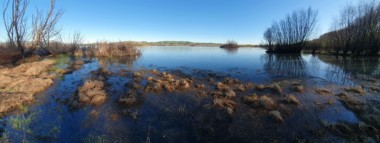Field Sampling
It takes the Lakes380 team between 2 to 5 hours to sample a lake
What samples are collected?
- Surface sediment (lake bottom)
- Sediment core
- Water samples
Collecting surface sediments
Surface sediments from the lake bottom are collected by:
A sediment corer. This is lowered to the lake-bed on a rope. It then sinks into the mud (about 25 cm) and a special stopper is launched that seals the tube. The corer is then pulled to the surface and the top 2 cm pushed out of the tube and sliced off into a sediment collection device.
Ponar grab. This is like a big set of metal jaws. It is l held open by a spring-loaded pin and lowered on a rope to the lake bed. This fires when the Ponar hits the lake-bed and allows the ‘jaws’ to close – collecting a scoop of sediment.
Surface sediment samples are used for: environmental DNA and nutrient analysis.
How do you collect sediment cores?
To be able to study lake history sediment needs to be extracted from the lakebed with the layers of mud still intact.
To extract the mud, long tubes attached to a corer are hammered into the bottom of the lake. A vacuum seal at the top of the corer stops the mud slipping out of the tube as it is pulled from the lake.
Collecting water samples
Water samples are collected from each lake by filling a bottle of water. When lakes are less than 10 meters deep the samples are collected near the surface. In deeper lakes we also collect a sample from about 1 meter above the lake bed.
We also take measurements through the lakes water column measuring temperature, dissolved oxygen concentration, pH and light.











